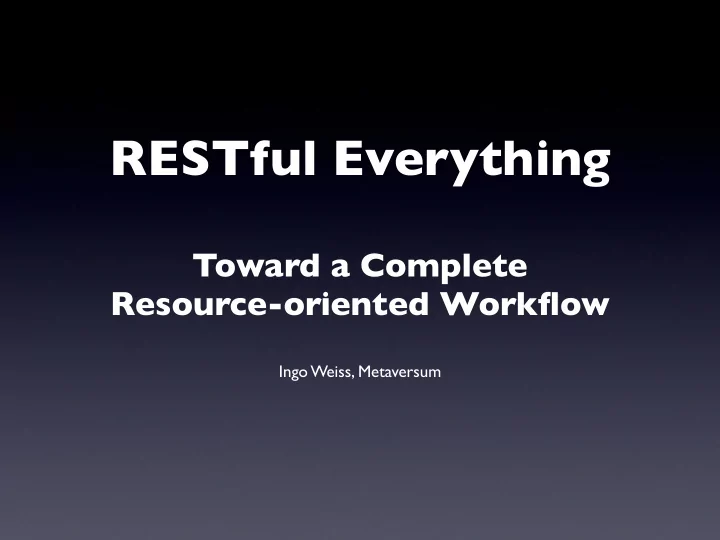

RESTful Everything Toward a Complete Resource-oriented Workflow Ingo Weiss, Metaversum
1. What is resource-orientation? 2. How does present Rails development benefit from resource-orientation? 3. Could it benefit more? How?
1. What is resource- orientation? This section merely summarizes parts of the ‘Resource-oriented Architecture’ (ROA) as outlined in the excellent book ‘RESTful Web Services’ by Leonard Richardson and Sam Ruby
1. Statelessness 2. Addressability 3. Uniform Interface 4. Connectivity
Uniform Interface GET POST PUT DELETE
Connectivity • Resources should be connected by links and forms linking to possible next application states • ‘Hypermedia as the engine of application state’ • Links and forms are acting as ‘Levers of state’
II. How does current RAILS development benefit from resource- orientation?
1. Rails Routes
map.resources :tasks
GET /tasks index POST /tasks create GET /tasks/new new GET /tasks/1/edit edit GET /tasks/1 show PUT /tasks/1 update DELETE /tasks/1 destroy
/tasks /tasks/1 /tasks/new /tasks/edit GET index show new edit POST create PUT update DELETE destroy
tasks_path /tasks task_path(task) /tasks/1 new_task_path /tasks/new edit_task_path(task) /tasks/1/edit
2. Rails Controllers
class TasksController < ApplicationController def index def create def new def edit def show def update def destroy end
3. Rails Views
<%- content_tag_for :li, task do -%> <%= link_to(task.name, task_path(task)) %> <%= link_to('Edit', edit_task_path(task)) %> <%- form_for(task, :html => {:method => :delete}) do |form| -%> <%= submit_button 'Delete' %> <%- end -%> <%- form_for :completion, :url => task_completion_path(task) do |form| -%> <%= submit_button 'Done' %> <%- end -%> <%- form_for task do |form| -%> <%= form.select :assignee, ['Joe', 'Janet', 'Jane'] %> <%= submit_button 'Assign' %> <%- end -%> <%- form_for task do |form| -%> <%= hidden_field_tag 'task[assignee]', 'Me' %> <%= submit_button 'Assign to me' %> <%- end -%> <%- end -%>
<%- content_tag_for :li, task do -%> <%= link_to(task.name, task_path(task)) %> <%= link_to('Edit', edit_task_path(task)) %> <%- form_for(task, :html => {:method => :delete}) do |form| -%> <%= submit_button 'Delete' %> <%- end -%> <%- form_for :completion, :url => task_completion_path(task) do |form| -%> <%= submit_button 'Done' %> <%- end -%> <%- form_for task do |form| -%> <%= form.select :assignee, ['Joe', 'Janet', 'Jane'] %> <%= submit_button 'Assign' %> <%- end -%> <%- form_for task do |form| -%> <%= hidden_field_tag 'task[assignee]', 'Me' %> <%= submit_button 'Assign to me' %> <%- end -%> <%- end -%>
• URL and HPPT methods are sometimes implicit, sometimes explicit • CRUD actions are (mostly) absent • Forms and Links are treated very differently • Knowledge of both routing rules and helper syntax required • Syntax is elegant in some places at the expense of consistency and expressiveness
<li class="task" id="task_1"> <a href="/tasks/1">Water plants</a> <a href="/tasks/1/edit">Edit</a> <form action="/tasks/1" class="edit_task" id="edit_task_1" method="post"> <input name="_method" type="hidden" value="delete" /> <button>Delete</button> </form> <form action="/tasks/1/completion" method="post"> <button type="submit">Done</button> </form> <form action="/tasks/1" class="edit_task" id="edit_task_1" method="post"> <input name="_method" type="hidden" value="put" /> <select id="task_assignee" name="task[assignee]"> <option value="Joe">Joe</option> <option value="Janet">Janet</option> <option value="Jane">Jane</option> </select> <button type="submit">Assign</button> </form> <form action="/tasks/1" class="edit_task" id="edit_task_1" method="post"> <input name="_method" type="hidden" value="put" /> <input id="task[assignee]" name="task[assignee]" type="hidden" value="Ingo" /> <button type="submit">Assign to me</button> </form> </li>
• No consistent pattern for classes and ids across links and form • Increased likelihood of inconsistent, representational class/id attributes • Many micro-dependencies that make the code brittle and hard to change
What if view helpers would...? • use the same syntax for both links and forms • focus on the things that matter: Resource, action, parameters • consistently set true resource-oriented class attributes
ResourcefulViews • Plugin • Extends the map.resources method to define a set of seven view helpers for each resource, one for each CRUD action • Best demonstrated by example...
<%- content_tag_for :li, task do -%> <%= link_to(task.name, task_path(task)) %> <%= link_to('Edit', edit_task_path(task)) %> <%- form_for(task, :html => {:method => :delete}) do |form| -%> <%= submit_button 'Delete' %> <%- end -%> <%- form_for :completion, :url => task_completion_path(task) do |form| -%> <%= submit_button 'Done' %> <%- end -%> <%- form_for task do |form| -%> <%= form.select :assignee, ['Joe', 'Janet', 'Jane'] %> <%= submit_button 'Assign' %> <%- end -%> <%- form_for task do |form| -%> <%= hidden_field_tag 'task[assignee]', 'Ingo' %> <%= submit_button 'Assign to me' %> <%- end -%> <%- end -%>
<%- task_item task do -%> <%= show_task(task, :label => task.name) %> <%= edit_task(task) %> <%= destroy_task(task) -%> <%= create_task_completion(task, :label => ‘Done’) -%> <%- update_task(task) do |form| -%> <%= form.select :assignee, ['Joe', 'Janet', 'Jane'] %> <%= submit_button 'Assign' %> <%- end -%> <%= update_task(task, :attributes => {:assignee => ‘Me’}, :label => ‘Assign to me’) -%> <%- end -%>
The Helpers • Are named following the pattern: [CRUD action]_[resource name] [CRUD action]_[name prefix]_[resource name] • Render either a link or a form generating a request that will be routed to that CRUD action • Take the same parameters as the named route used to generate the request’s target URL, plus some options • Set resource-oriented class attributes
<li class="task" id="task_1"> <a href="/tasks/1" class="task show show_task">Water plants</a> <a href="/tasks/1/edit" class="task edit edit_task">Edit</a> <form action="/tasks/1" class="task destroy destroy_task" method="post"> <input name="_method" type="hidden" value="delete" /> <button type="submit">Delete</button> </form> <form action="/tasks/1/completion" class="completion create create_completion" method="post"> <button type="submit">Done</button> </form> <form action="/tasks/1" class="task update update_task" method="post"> <input name="_method" type="hidden" value="put" /> <select id="task_assignee" name="task[assignee]"> <option value="Janet">Janet</option> <option value="Jane">Jane</option> <option value="Joe">Joe</option> </select> <button type="submit">Assign</button> </form> <form action="/tasks/1" class="task update update_task" method="post"> <input name="task[assignee]" type="hidden" value="Me" /> <input name="_method" type="hidden" value="put" /> <button type="submit">Assign to me</button> </form> </li>
Another view example
<%= new_task %> <a href=”/tasks/new” class=”task new new_task”>New</a>
<%= new_task :attributes => {:assignee => ‘Fred’}, :label => ‘Ask Fred’ %> <a href=”/tasks/new?task[assignee]=Fred” class=”task new new_task”>Ask Fred</a>
Recommend
More recommend